Stewart J. College Algebra: Concepts and Contexts
Подождите немного. Документ загружается.

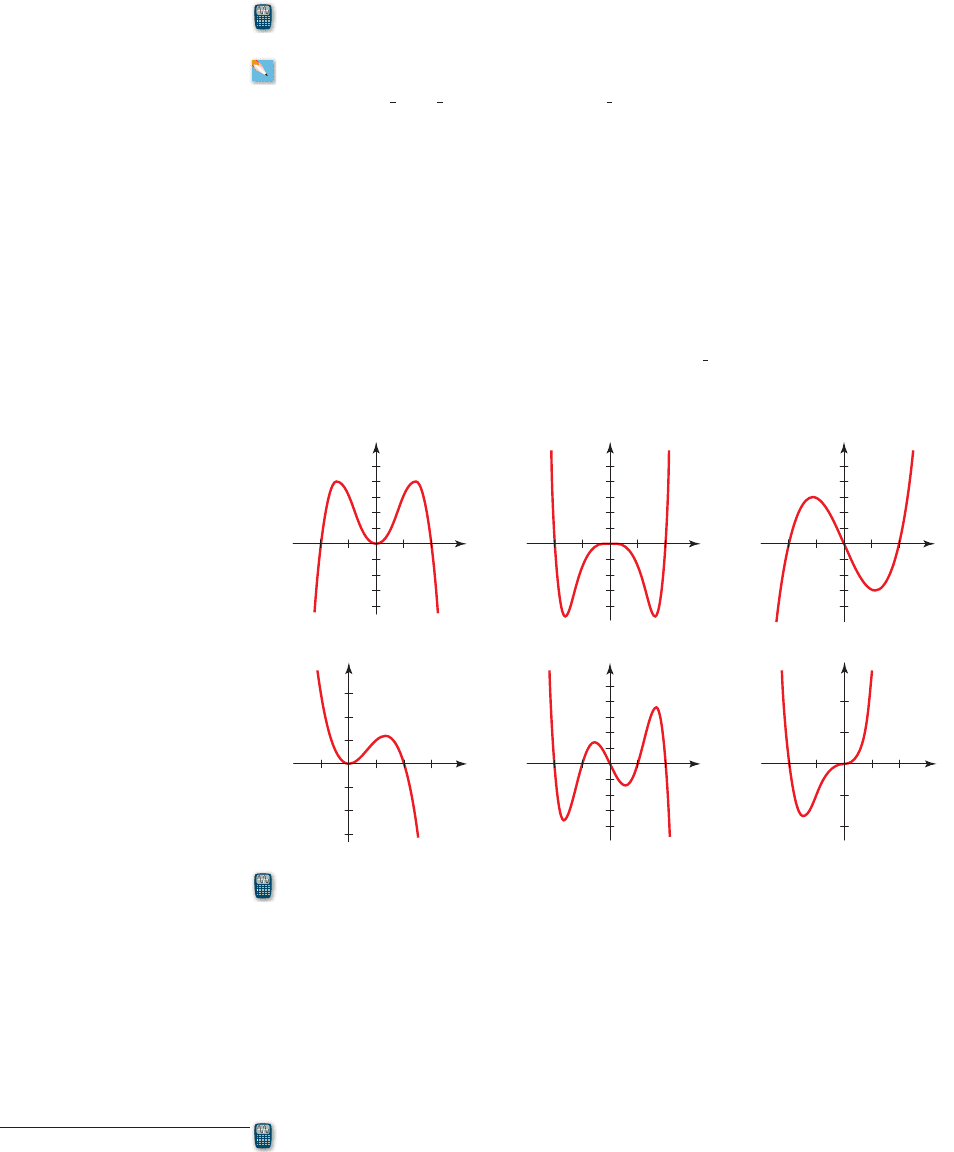
514 CHAPTER 6
■
Power, Polynomial, and Rational Functions
27–32
■ Determine the end behavior of P. Compare the graphs of P and Q on large and
small viewing rectangles as in Example 5.
27.
28
29.
30
31.
32
33–38
■ Match the polynomial function with one of the graphs I–VI. Give reasons for your
choice.
33. 34.
35. 36.
37. 38. U1x 2=-x
3
+ 2x
2
T1x 2= x
4
+ 2x
3
S1x 2=
1
2
x
6
- 2x
4
R1x 2=-x
5
+ 5x
3
- 4x
Q1x 2=-x
2
1x
2
- 42P 1x 2= x1x
2
- 42
P1x 2= 2x
2
- x
12
,Q1x 2=-x
12
P1x 2= x
11
- 9x
9
,Q1x 2= x
11
P1x 2=-x
5
+ 2x
2
+ x,Q1x 2=-x
5
P1x 2= x
4
- 7x
2
+ 5x + 5,Q1x2= x
4
P1x 2=-
1
8
x
3
+
1
4
x
2
+ 12x,Q1x 2=-
1
8
x
3
P1x 2= 3x
3
- x
2
+ 5x + 1,Q1x2= 3x
3
43. Market Research A market analyst working for a small appliance manufacturer finds
that if the firm produces and sells x blenders annually, a model for the total profit (in
dollars) is
P 1x2= 8x + 0.3x
2
- 0.001x
3
- 372
y
y
y
y y y
x
xxx
I II III
IV
0
1
1
0
1
1
x
0
1
1
0
1
1
VVI
x
0
1
1
0
1
1
39–42 ■ A polynomial function P is given.
(a) Graph the polynomial P in the given viewing rectangle.
(b) Find all the local maxima and minima of P.
(c) Find all solutions of the equation .
39. by
40. by
41. by
42. by [ ]- 40, 40P 1x 2= 2x
3
- 8x
2
+ 9x - 9;3- 4, 64
3- 5, 104P 1x 2= x
5
- 5x
2
+ 6;3- 3, 34
3- 30, 304P 1x2= x
4
- 5x
2
+ 4;3- 4, 44
3- 15, 154P 1x2= x
3
- 3x
2
- 4x + 12;3- 4, 44
P 1x 2= 0
CONTEXTS
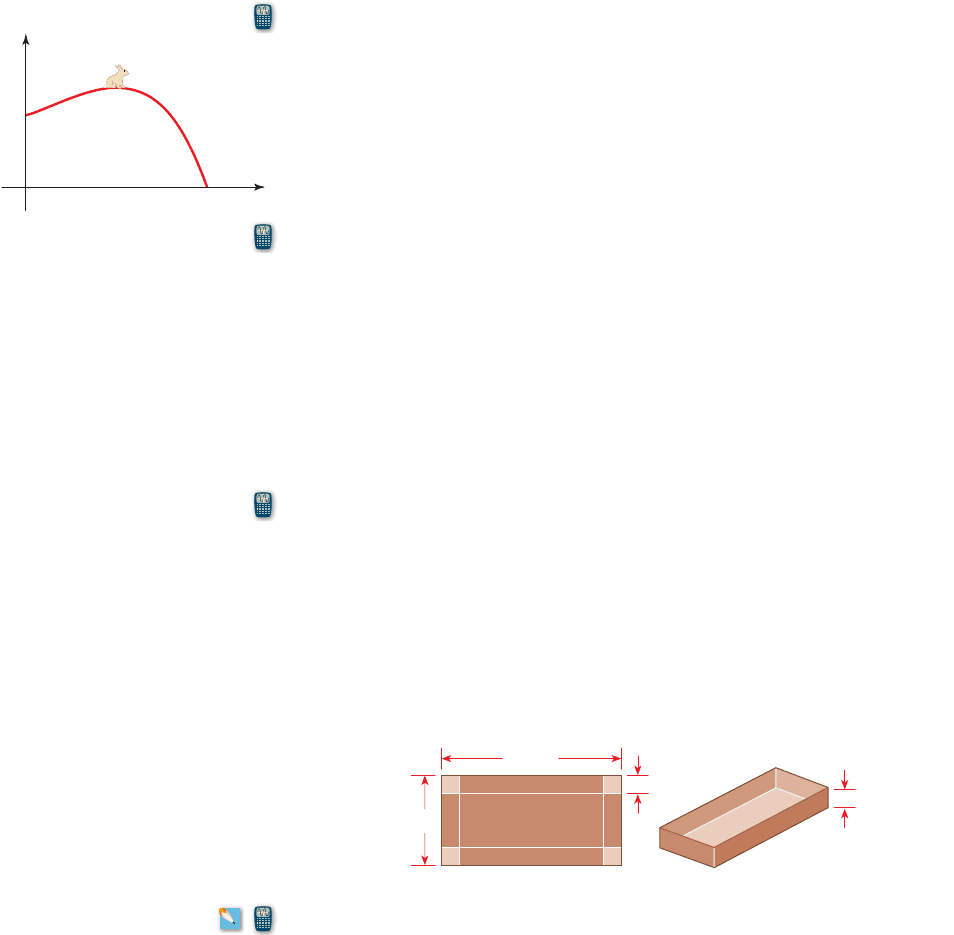
SECTION 6.3
■
Polynomial Functions: Combining Power Functions 515
Graph the function P in an appropriate viewing rectangle, and use the graph to answer
the following questions.
(a) When just a few blenders are manufactured, the firm loses money (profit is
negative). (For example, , so the firm loses $263.30 if it produces
and sells only 10 blenders.) How many blenders must the firm produce to break
even?
(b) Does profit increase indefinitely as more blenders are produced and sold? If not,
what is the largest possible profit the firm could have?
44. Population Change The rabbit population on a small island is observed to be
modeled by the function.
where t is the time (in months) since observations of the island began. Graph the
function P in an appropriate viewing rectangle, and use the graph to answer the
following questions.
(a) When is the maximum population attained, and what is that maximum population?
(b) When does the rabbit population disappear from the island?
45. Depth of Snowfall Snow began falling at noon on Sunday. The amount of snow on
the ground at a certain location at time t was modeled by the function.
where t is measured in days from the start of the snowfall and h(t) is the depth of snow
in inches. Graph this function in an appropriate viewing rectangle, and use your graph
to answer the following questions.
(a) What happened shortly after noon on Tuesday?
(b) Were there ever more than 5 inches of snow on the ground? If so, on what day(s)?
(c) On what day and at what time (to the nearest hour) did the snow disappear
completely?
46. Volume of a Box An open box is to be constructed from a piece of cardboard 20 cm
by 40 cm by cutting squares of side length x from each corner and folding up the sides,
as shown in the figure.
(a) Show that the volume of the open box is given by the function
(b) What is the domain of ? (Use the fact that length and volume must be positive.)
(c) Draw a graph of the function , and use it to estimate the maximum volume for
such a box.
V
V
V1x 2= 4x
3
- 120x
2
+ 800x
h1t 2= 11.60t - 12.41t
2
+ 6.20t
3
- 1.58t
4
+ 0.20t
5
- 0.01t
6
P 1x2= 120t - 0.4t
4
+ 1000
P1102=-263.3
t
P
0
20 cm
40 cm
x
x
47. Volume of a Box A cardboard box has a square base, with each edge of the base
having length x inches, as shown in the figure on the following page. The total length of
all 12 edges of the box is 144 inches.
(a) Show that the volume of the open box is given by the function
V1x 2= 2x
2
118 - x 2

30 ft
516 CHAPTER 6
■
Power, Polynomial, and Rational Functions
(b) What is the domain of ? (Use the fact that length and volume must be positive.)
(c) Draw a graph of the function , and use it to estimate the maximum volume for
such a box.
48. Girth of Box Acme Postal Service will mail a package only if the length plus girth of
the package is 150 inches or less. Ranil wants to mail a package in the shape of a
rectangular box with a square base. To get the largest volume, he wants the length plus
the girth to be exactly 150 inches.
(a) Express the volume of the package as a function of the side x of the base.
(b) Use a graphing calculator to graph in the viewing rectangle [0, 40] by
[0, 35,000]. For what value of x does the maximum volume occur?
(c) What are the dimensions of the box with greatest volume that Ranil can mail with
Acme Postal Service?
49. Girth of Box If the box in Exercise 48 is to have a volume of 12,000 cubic inches,
what are its dimensions?
50. Volume of a Silo A grain silo consists of a 30-foot-tall cylindrical main section and a
hemispherical roof.
(a) Show that the volume of the silo is given by the function
where r is the radius of the cylinder.
(b) If the total volume of the silo (including the part inside the roof section) is 15,000
cubic feet, what is the radius?
V =
2
3
pr
3
+ 30pr
2
V
V
V
V
V
x
x
2
6.4 Fitting Power and Polynomial Curves to Data
■
Fitting Power Curves to Data
■
A Linear, Power, or Exponential Model?
■
Fitting Polynomial Curves to Data
IN THIS SECTION… we model data using power and polynomial functions.
Power and polynomial functions are the fundamental tools for modeling many real-
world problems. One of the examples we study in this section is the species-area
relation—the relation between the area of an “island” and the number of species in-
habiting it. The term island simply means any well-defined ecosystem, such as a for-
est or a mountaintop. The species-area relation is one of the most consistently veri-
fied principles in ecology. Understanding this relation helps ecologists set
conservation standards that take into account the biodiversity of an ecosystem. To
model the species-area relation, scientists collect data on the number of species of a
particular type of plant or animal in areas of different size. We’ll see that such data
are often best modeled by a power function. Once the model has been found, the ex-
pected number of species in a given area can be determined by using the model. The
process is summarized in the following steps.
■
Data are collected on the areas of different regions and the number of
species in each region.
■
A power model that best fits the data is made.
The number of different bat
species in a cave is related to the
size of the cave by a power
function.
TheSupe87/Shutterstock.com 2009
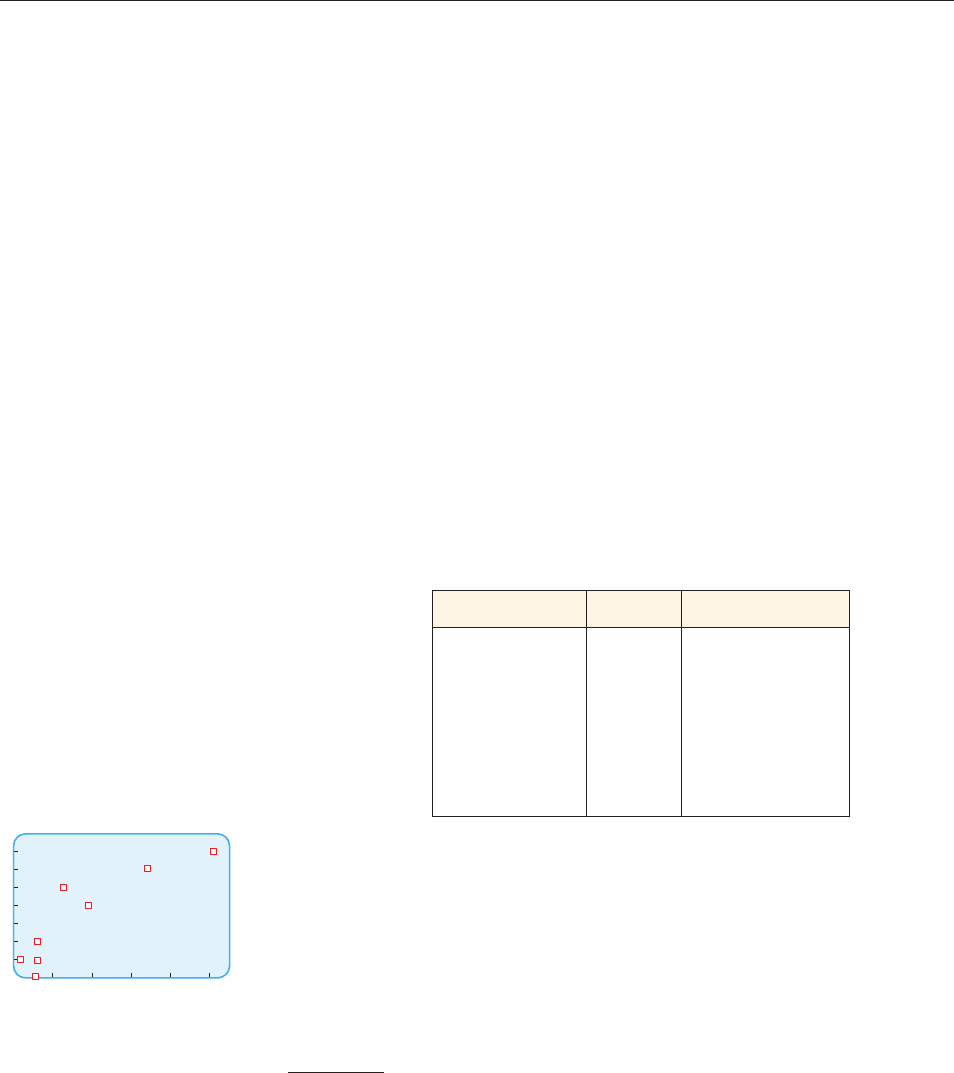
SECTION 6.4
■
Fitting Power and Polynomial Curves to Data 517
■
The model is used to estimate the number of species in a region with a
given area.
This species-area model is described in Example 1 for cave bats.
2
■ Fitting Power Curves to Data
If a scatter plot of the data we are studying resembles the graph of a power function,
then we seek a power model, that is, a function of the form
where C is a positive constant and p is any real number. In the next example we seek
a power model for the species-area relation for cave bats.
f 1x2= Cx
p
example
1
Modeling the Species-Area Relation
Table 1 gives the areas of several caves in central Mexico and the number of bat
species that live in each cave.*
(a) Make a scatter plot of the data. Is a linear model appropriate?
(b) Find a power function that models the data.
(c) Draw a graph of the function you found and a scatter plot of the data on the
same graph. Does the model fit the data well?
(d) The cave called El Sapo near Puebla, Mexico, has a surface area of
. Use the model to estimate the number of bat species you would
expect to find in that cave.
A = 205 m
2
*A. K. Brunet and R. A. Medallin, “The Species-Area Relationship in Bat Assemblages of Tropical
Caves,” Journal of Mammalogy, 82(4):1114–1122, 2001.
table 1
Species-area data
Cave
Area
1m
2
2
Number of species
La Escondida 18 1
El Escorpion 19 1
El Tigre 58 1
Mision Imposible 60 2
San Martin 128 5
El Arenal 187 4
La Ciudad 344 6
Virgen 511 7
Solution
(a) The scatter plot shown in Figure 1 indicates that the plotted points do not lie
along a straight line, so a linear model is not appropriate.
(b) Using a graphing calculator and the
PwrReg command (see Figure 2(a) on the
next page), we get the power model
(where we have rounded to two decimals).
S = 0.14A
0.64
0
550
8
figure 1 Scatter plot of cave-bat
data

518 CHAPTER 6
■
Power, Polynomial, and Rational Functions
(d) The area A is , so our model gives
Model
Replace A by 205
Calculator
We would expect about 4 bat species in the El Sapo cave.
■ NOW TRY EXERCISE 15 ■
S L 4.22
S = 0.14
#
205
0.64
S = 0.14A
0.64
205 m
2
(c) The graph is shown in Figure 2(b). The model appears to fit the data well.
0
550
8
(b) Graph of S=0.14A
0.64
(a) PwrReg output
PwrReg
y=a*x^b
a=0.140019
b=0.640512
figure 2 Power model for species-area relationship
2
■ A Linear, Power, or Exponential Model?
In Section 2.5 we learned that if a scatter plot of data lies approximately on a line,
then a linear model is appropriate. But suppose that a scatter plot shows that the data
increase rapidly. Should we use an exponential function or a power function to
model the data? To help us decide, let’s recall from Exploration 3 following Chapter 4
(page 406) that if the data points (x, y) lie on an exponential curve, then a plot of
the points (x, log y), called a semi-log plot, lies on a straight line. We now show that
if the data points (x, y) lie on a power curve, then a plot of the points (log x, log y),
called a log-log plot, would lie on a line.
Suppose the data points (x, y) lie on a power curve . Let’s take the log-
arithm of each side of this equation.
Given equation
Take log of each side
Property of log
Property of log
To see that log y is a linear function of log x, let , , and .
Then the last equation becomes
We recognize that Y is a linear function of X, so the points (X, Y) or (log x, log y) lie
on a straight line. We now summarize our observations.
Y = A + pX
A = log CX = log xY = log y
log y = log C + p log x
log y = log C + log x
p
log y = log Cx
p
y = Cx
p
y = Cx
p
The El Sapo cave actually does have
four species of bats.
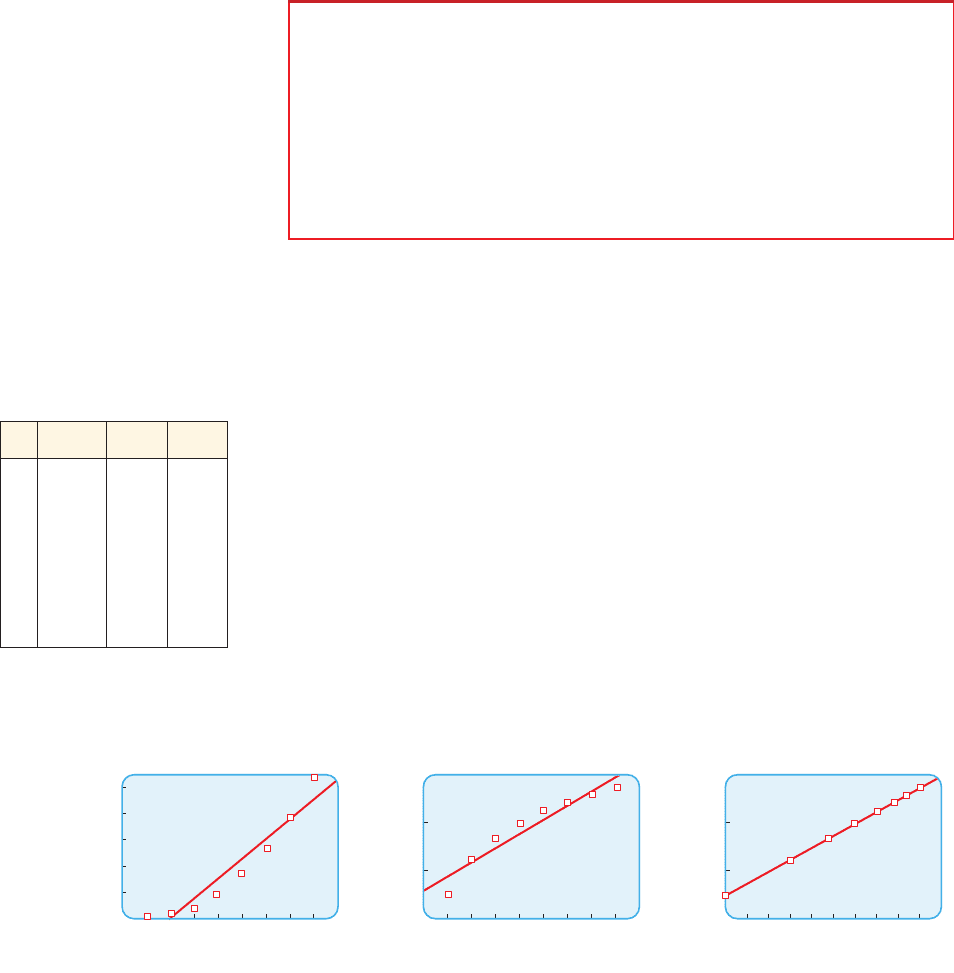
SECTION 6.4
■
Fitting Power and Polynomial Curves to Data 519
To determine whether a linear, exponential, or power model is appropriate,
we make a scatter plot, a semi-log plot, and a log-log plot.
■
If the scatter plot of the data lie approximately on a line, then a linear
model is appropriate.
■
If the semi-log plot of the data lie approximately on a line, then an
exponential model is appropriate.
■
If the log-log plot of the data lie approximately on a line, then a power
model is appropriate.
Linear, Power, or Exponential Model?
To determine whether the plots lie on a line, we graph the regression line for
each plot, as we show in the next example.
example
2
A Linear, Power, or Exponential Model?
Data points (x, y) are given in Table 2. (For convenience we’ve also included the val-
ues of log x and log y.)
(a) Make a scatter plot, a semi-log plot, and a log-log plot of the data. Also graph
the regression line for each set of data.
(b) Is a linear, power, or exponential model appropriate?
(c) Find an appropriate model for the data, and then graph the model together
with a scatter plot of the data.
Solution
(a) For a scatter plot of the data we graph the points (x, y). For the semi-log plot
we graph the points (x, log y), and for the log-log plot we graph the points
(log x, log y). We use the calculator to find the regression line for each data set.
Each data set together with its regression line is shown in Figure 3.
x y log x log y
1 3.0 0 0.48
2 17.1 0.30 1.23
3 46.8 0.48 1.67
4 96.0 0.60 1.98
5 167.7 0.70 2.22
6 264.6 0.78 2.42
7 388.9 0.85 2.59
8 543.0 0.90 2.73
table 2
0
1
3
(c) Log-log plot
y
=0.477+2.50x
0
9
3
(b) Semi-log plot
y
=0.573+0.299x
0
9
550
(a) Scatter plot
y
=_150+75.763x
figure 3
(b) From Figure 3 we see that the log-log plot lies along a line much more closely
than the other plots, so we conclude that a power model is appropriate.
(c) Using the PwrReg command on a graphing calculator, we get the power model
y = 3.0
#
x
2.5
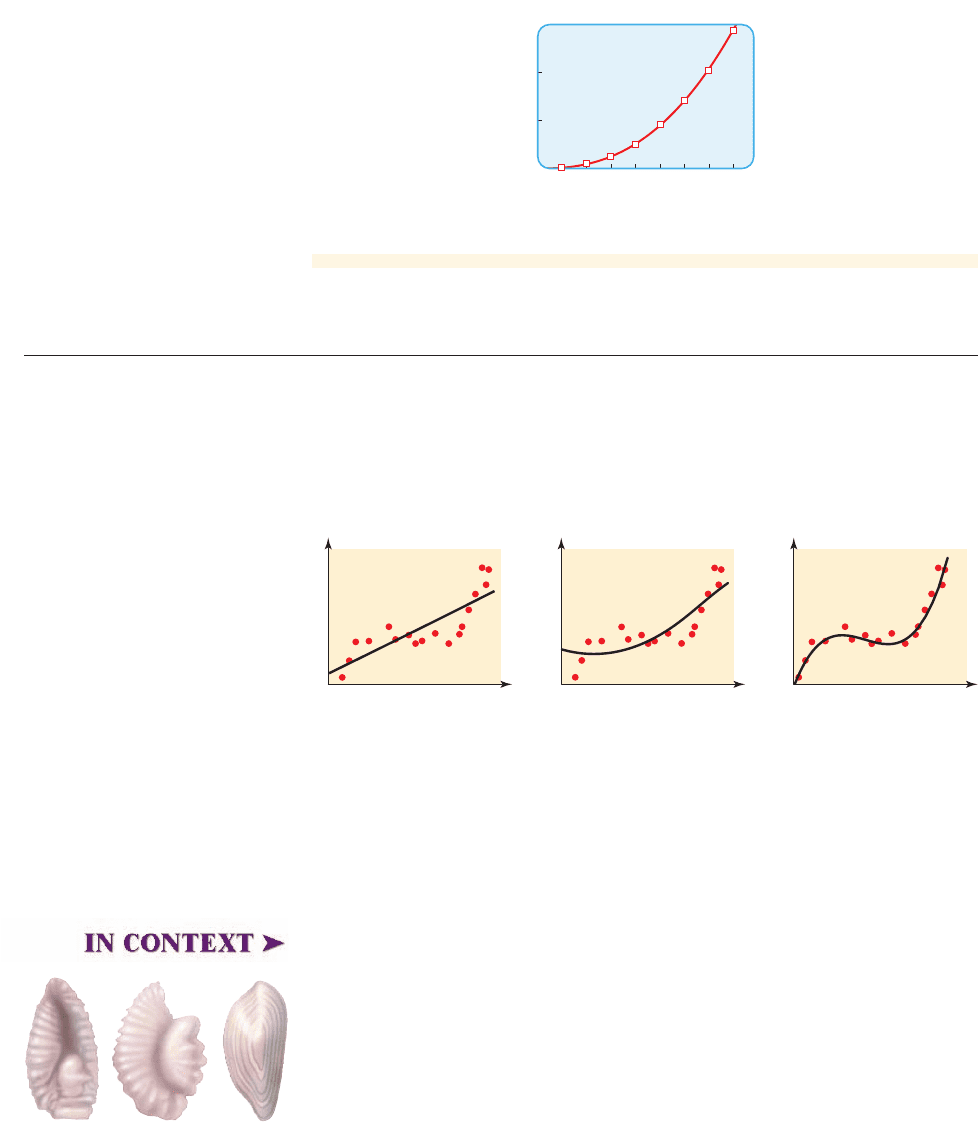
520 CHAPTER 6
■
Power, Polynomial, and Rational Functions
The graph of this function and the original data points are shown in
Figure 4.
0
1
3
figure 4 Scatter plot and model
■ NOW TRY EXERCISE 11 ■
2
■ Fitting Polynomial Curves to Data
We have learned how to fit a line to data (Section 2.6) or a power function to data. If
the data exhibit more variability than either of these two models, we may need a dif-
ferent type of function to model the data. Figure 5 shows a scatter plot with three
possible models that appear to fit data. Which model fits the data best?
y
x
y
x
Linear model
Q
uadratic model Cubic model
y
x
figure 5 Different types of
models for the data
Although we can always find the linear model or the power model that best fits
these data, it is clear from Figure 5 that the cubic model fits the data better than the
others do. In fact, polynomial functions are ideal for modeling data for which the
scatter plot has peaks or valleys (that is, local maxima or minima). For example, if
the data have a single peak, then it may be appropriate to use a quadratic polynomial
to model. The more peaks or valleys the data exhibit, the higher the degree of the
polynomial needed to model the data (see Figure 5).
Marine biologists need to be able to determine the ages of fish so that they can
track fish populations and help to protect and manage this valuable resource. The age
of a fish can be determined by the otoliths (“ear stones”) in the head of the fish. These
tiny structures have microscopic growth rings, not unlike growth rings of trees,
which record the age of a fish. The art in the margin shows examples of otoliths of
some fish species. Using otoliths, scientists collect data on the age and lengths of a
particular species of fish.
We’ll see in the next example that data on the length and age of fish are often
best modeled by cubic polynomials. Once the model has been found, the age of a fish
IN CONTEXT ➤
Cod Redfish Hake
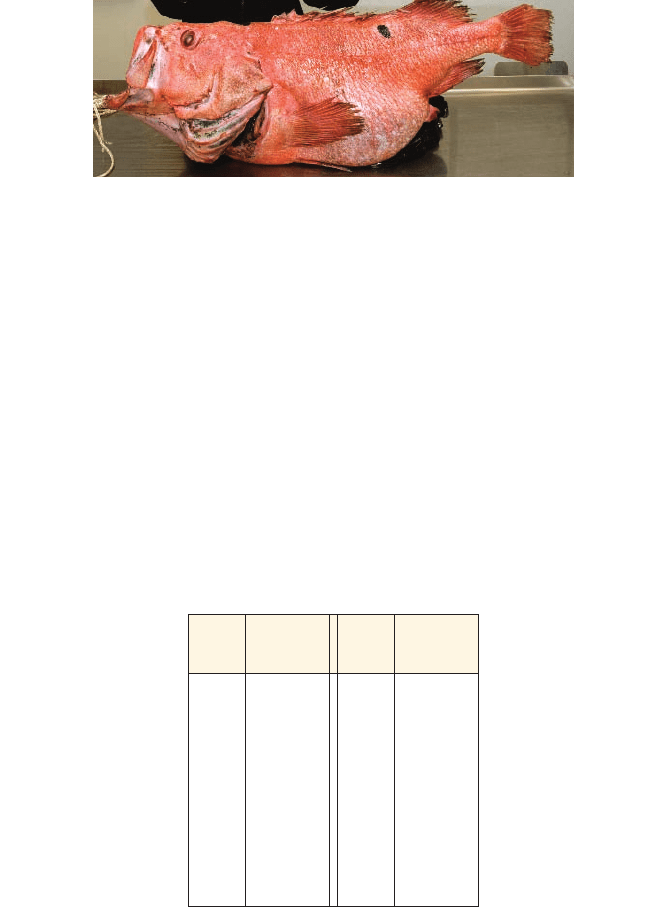
can be estimated from its length (without further need to examine the otoliths of each
fish). One of the oldest fish ever recorded was caught off the coast of Alaska in 2007.
Its age was estimated through the otoliths to be between 90 and 115 years.
90-year old rockfish
example
3
Length-at-Age Data for Fish
The table gives the lengths of rock bass caught at different ages, as determined by
the otoliths. Scientists have proposed a cubic polynomial to model the data.
(a) Use a graphing calculator to find the cubic polynomial of best fit for the data.
Draw a graph of the polynomial function you found, together with a scatter
plot of the data.
(b) Use the model to estimate the length of a 5-year-old rock bass.
(c) A fisherman catches a rock bass that is 20 inches long. Use the model to
estimate its age.
table
3
Length-at-age data
SECTION 6.4
■
Fitting Power and Polynomial Curves to Data 521
Photo by Karna McKinney, AFSC, NOAA
Fisheries.
Age
(yr)
Length
(inches)
1 4.8
2 8.8
2 8.0
3 7.9
4 11.9
5 14.4
6 14.1
6 15.8
7 15.6
8 17.8
Age
(yr)
Length
(inches)
9 18.2
9 17.1
10 18.8
10 19.5
11 18.9
12 21.7
12 21.9
13 23.8
14 26.9
14 25.1
Solution
(a) Using the CubicReg command on a graphing calculator (see Figure 6(a) on
the next page), we find the cubic polynomial of best fit:
y = 0.0155x
3
- 0.372x
2
+ 3.95x + 1.21
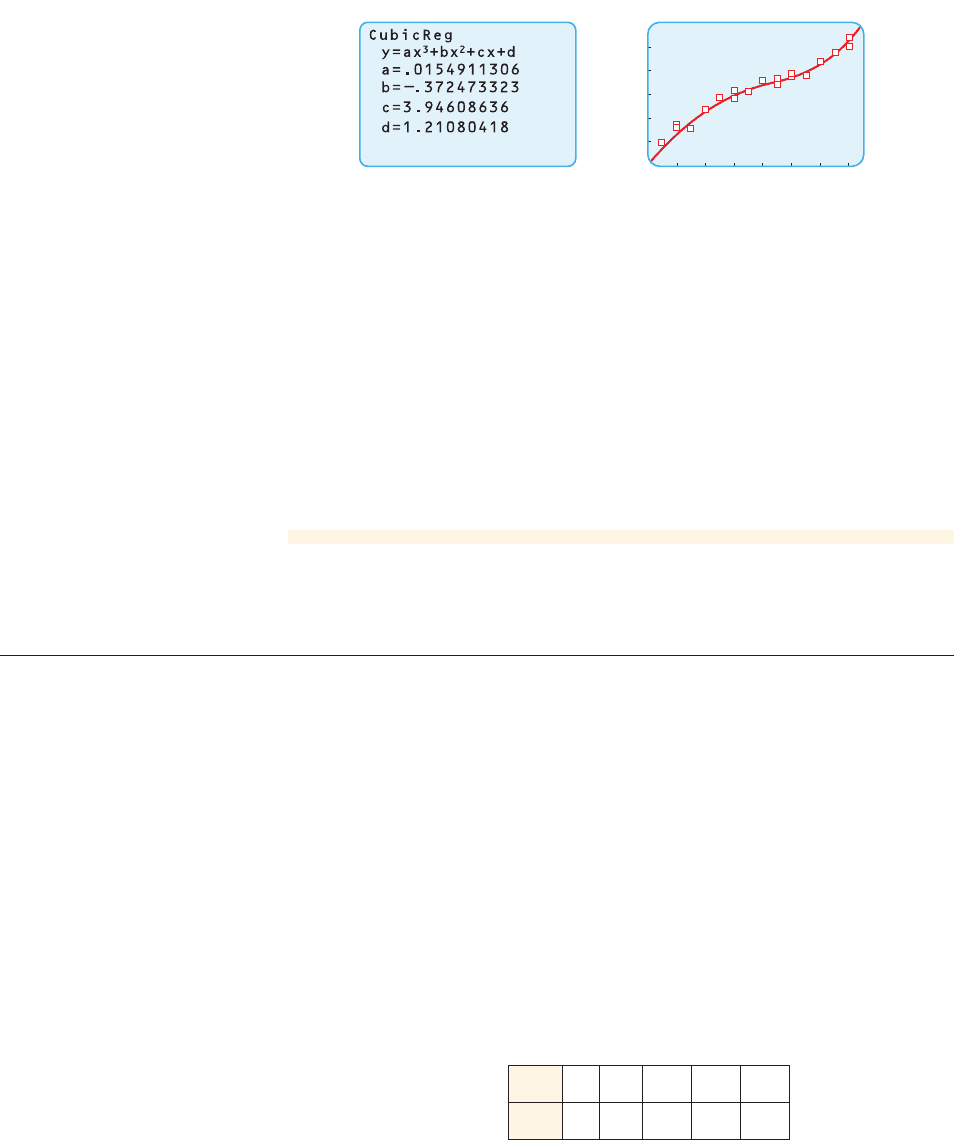
522 CHAPTER 6
■
Power, Polynomial, and Rational Functions
(b) Scatter plot and model
(a)
CubicReg output
30
15
0
figure 6 Cubic polynomial model for length-at-age data
x 12345
f 1x 2
5 40 135 320 625
(b) We replace x by 5 in the model.
Model
Replace x by 5
Calculator
So a 5-year-old rock bass would be approximately 13.6 inches long.
(c) Moving the cursor along the graph of the polynomial in Figure 6(b), we find
that y is 20 when x is approximately 10.8. So the fish is about 10.8 years old.
■ NOW TRY EXERCISE 21 ■
y L 13.6
y = 0.015515 2
3
- 0.37215 2
2
+ 3.9515 2+ 1.21
y = 0.0155x
3
- 0.372x
2
+ 3.95x + 1.21
Fundamentals
1. (a) When modeling data, we make a _____________ plot to help us visually
determine whether a line or some other curve is appropriate for modeling the data.
(b) If the y-values of a set of data increase rapidly, then an exponential function or a
_____________ function may be appropriate for modeling the data.
2. To determine whether an exponential function or a power function is appropriate for
modeling a set of data, we make a semi-log plot and a log-log plot of the data.
(a) If the semi-log plot lies approximately along a line, then a
_____________
model is appropriate.
(b) If the log-log plot lies approximately along a line, then a
_____________
model is appropriate.
Think About It
3–4 ■ The following data are obtained from the function .f 1x2= 5x
3
6.4 Exercises
CONCEPTS
Here, x is age in years and y is length in inches. A scatter plot of the data
together with a graph of the cubic polynomial model is shown in Figure 6(b).
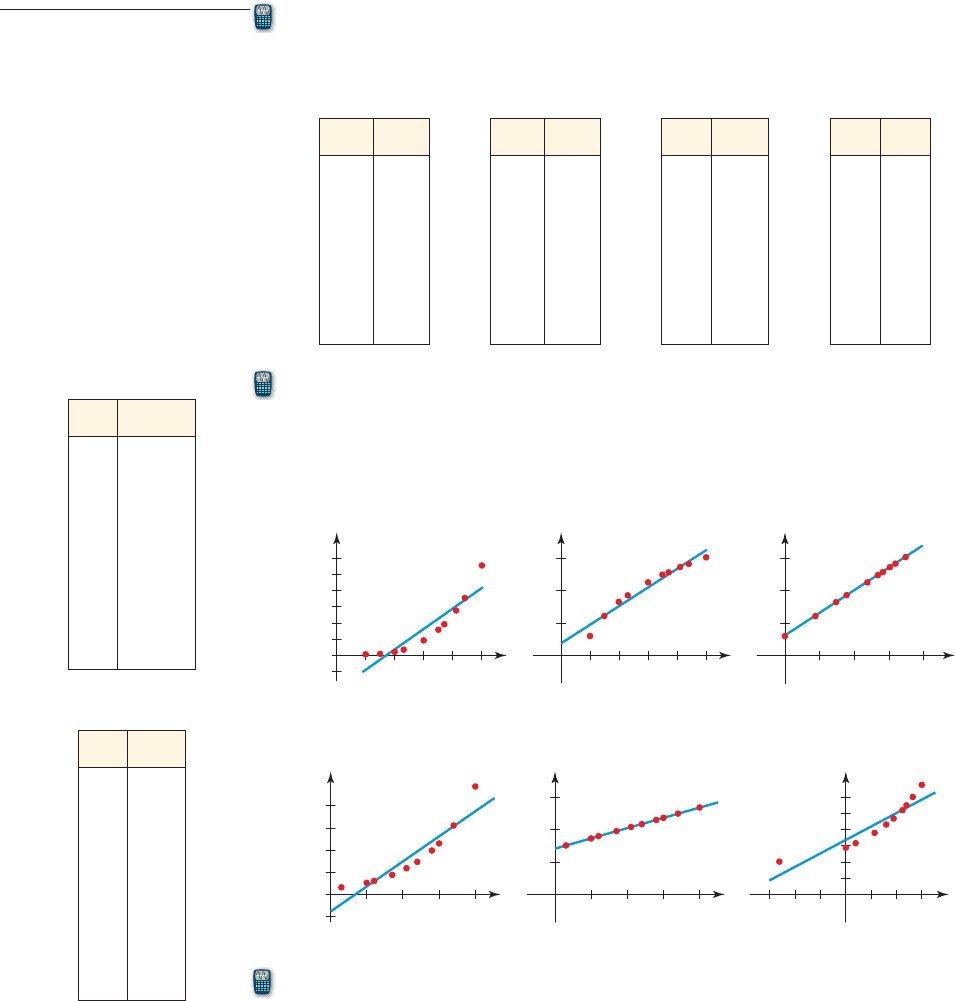
SECTION 6.4
■
Fitting Power and Polynomial Curves to Data 523
3. If you use your calculator to find the power function that best fits the data, what
function would you expect to get? Try it.
4. If you use your calculator to find the cubic polynomial that best fits the data, what
function would you expect to get? Try it.
5–8
■ A set of data is given.
(a) Use your calculator to find the indicated model for the data.
(b) Graph a scatter plot of the data along with your model. Does the model fit the data?
5. Power: 6. Linear: 7. Cubic: 8. Exponential:
SKILLS
x
f 1x 2
1.0 4
1.5 16.5
2.0 45.3
2.3 73.8
3.0 187.1
3.5 320.9
3.7 389.7
4.1 558.2
4.4 714.7
5.0 1118.0
x
f 1x 2
0.3 1.50
1.0 1.72
1.2 1.79
1.7 1.95
2.1 2.08
2.4 2.17
2.8 2.30
3.0 2.37
3.4 2.50
4.0 2.69
x
f 1x 2
0.5 30
1.1 51
2.3 72
3.0 89
3.2 115
4.1 168
4.9 206
5.5 342
x
f 1x 2
0.6 24.2
1.5 32.8
2.0 34.0
2.4 33.2
3.9 24.9
4.8 20.6
5.2 22.7
5.6 25.8
x
f 1x 2
6 314
9 401
10 869
22 1126
29 1352
37 2251
62 3112
114 3551
x
f 1x 2
0.1 10
1.0 254
1.4 298
1.9 480
2.0 584
2.6 698
3.1 822
3.7 1141
10.
1200 3
2
1
1000
800
600
400
200
0
_200
yy
xx
Scatter plot
312 45
Semi-log plot Log-log plot
3
2
1
y
x
312 45 0.80.60.40.2
00
9–10 ■ A scatter plot, a semi-log plot, and a log-log plot for the set of data given in the
margin are shown below. Each graph also shows the regression line.
(a) Is a linear, exponential, or power function more appropriate for modeling the data?
(b) Find the model that is most appropriate, and graph the scatter plot along with your
model. Does the model fit the data?
9.
3
2
1.5
2.0
2.5
1
200
400
0
yy
xx
Scatter
p
lot
312 4
Semi-lo
g
p
lot Lo
g
-lo
g
p
lot
y
x
312 4 0.60.2_0.6 _0.2
0
11–14 ■ Data points (x, y) are given (see the next page).
(a) Draw a scatter plot of the data.
(b) Make semi-log and log-log plots of the data.
(c) Is a linear, power, or exponential function appropriate for modeling these data?
(d) Find an appropriate model for the data, and then graph the model together with a
scatter plot of the data.
Data for Exercise 9
Data for Exercise 10
